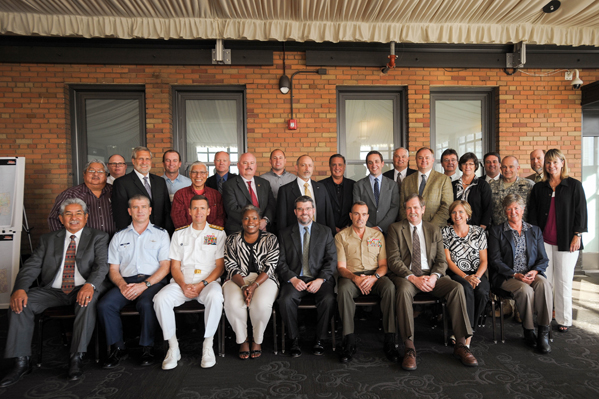By Kim Stevens
Aviation and airspace played a part in the Western Regional Partnership’s (WRP) Fifth Principals’ meeting held in Sacramento, California in September. The two-day meeting was hosted by the State of California and OSD. The mission of WRP is to provide “a proactive and collaborative framework for senior-policy level Federal, State and Tribal leadership to identify common goals and emerging issues in the states of Arizona, California, Nevada, New Mexico and Utah and to develop solutions that support WRP Partners and protect natural resources, while promoting sustainability, homeland security and military readiness.” 
The WRP Principals meet once each year to review WRP actions and provide policy input for the next year. The Fifth Principals’ meeting was attended by 110 people representing the Governors’ offices in the WRP states, Tribal representatives and Federal Agencies. WRP is Co-Chaired by the Honorable Gary Herbert, Governor of Utah, Mr. John Conger, Acting Deputy Under Secretary of Defense for Installations and Environment, and Ms. Marcilynn A. Burke Acting Assistant Secretary for Land and Minerals Management, U.S. Department of the Interior.
Members of the WRP committees, including the Military Readiness, Homeland Security, Disaster Preparedness and Aviation (MRHSDP&A) committee, provided an update on accomplishments over the past year as well as their recommended focus areas for 2013. (Photo- Principals)
The MRHSDP&A Committee focus areas and 2012 efforts included creating fact sheets on military installations and ranges in the WRP region and development of a document titled, “WRP State Support for Military Testing and Training Introduction on Department of Defense (DoD) Encroachment” which provides an overview of state laws and executive-level administrative support for the states in WRP. This document also highlights best practices in seven categories which may assist policy makers to develop additional tools to support the military mission.
The committee also created a WRP Airspace Sustainability Overview document, which outlines aviation issues along with recommendations on land encroachment/development, increased aviation operations, frequency/electromagnetic interference and new technologies. This document outlines aviation coordination/outreach best practices, aviation tools and resources as well as background/airspace definitional information. Highlighted during the presentation was the need for lighting and notification of MET towers under 200 feet.
Lt. Gen. Robin Rand, 12th Air Force (Air Forces Southern) Commander said that those who are involved in aviation and those involved in areas that impact aviation, have a responsibility to share the skies safely. "Resources like the Western Regional Partnership Airspace Sustainability Overview give us a starting point to address these important issues," said Rand. "As an Air Force pilot and commander of 65,000 Airmen, I can’t stress enough the need to collaborate and communicate about issues that play a role in airspace sustainability."
The MRHSDP&A Committee’s 2013 priorities include, drafting a Department of Defense 101 document to provide an overview of the DoD mission, updating the 2012 Airspace 101 guide for planners and policy makers, providing aviation updates including any changes in UAV operations in the region and working with other WRP committees on related efforts.
According to Brigadier General Vincent Coglianese, Commanding General, Marine Corps Installations West, Marine Corps Base Camp Pendleton, the Marine Corps, as the forward deploying Expeditionary Force of the Nation, has 85% of its aviation ranges and training areas and 65% of its ground ranges and training areas in the Western United States. Every Marine unit comes to the Western U.S. to practice their full mission profile skills at some point before their deployment. "This Region is critical to perfecting the combat readiness of your Nation’s Marines," said Coglianese. "Marines can operate rapidly over vast distances in today’s complex security environment to support our allies or defeat our Nation’s foes, but it takes collaboration, via organizations like the Western Regional Partnership, to help us all ensure we can operate safely amidst the many users of the Western Regions great airspace, lands, and water resources."
The next WRP Principals’ meeting is planned for Phoenix, Arizona in September 2013.




